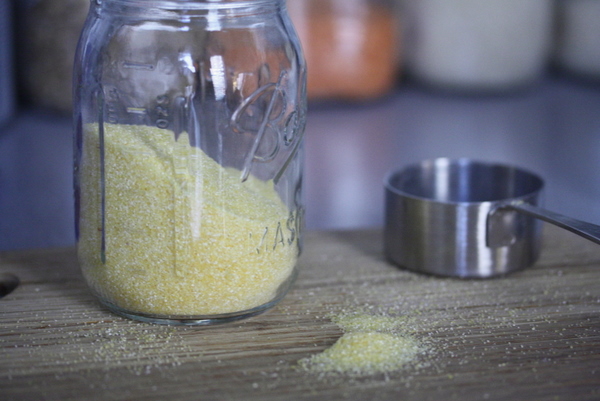
Creamy polenta has always seemed like a rather daunting dish to serve a crowd of guests. It takes longer to cook than one would imagine, and in my experience, it can transform from a soft, pillowy cushion into a rubbery, coarse brick in seconds. Because of this, I’ve always intentionally gone for the brick version for dinner parties.
Recently, I came across this Bittman article and discovered a different way of preparing polenta. Instead of pouring the cornmeal into boiling water in a steady stream and whisking furiously to prevent any lumps from forming, you start by creating a slurry off the heat. Once the polenta and water are thoroughly combined, you slowly bring it to a boil, then continue to add liquid to keep the creamy consistency until the grains are cooked through. The process of adding the liquid feels a lot like making risotto. And similarly, at the end of the cooking process, you can put on the lid and wait to finish the dish until you’re ready to serve your guests. It takes just a bit more liquid (in my case, milk) to loosen up the polenta and return it to a delightful cushion for whatever Italian specialty you choose to serve over it.
If you’ve ever had the experience of getting splattered by hot bubbles of polenta as it cooks (as I have a few scars to thank for this), you and your whisk will quickly be thanking Mr. Bittman as your polenta cooks evenly and mess-free.
From my kitchen, perfecting polenta, to yours,
Phoebe, THE QUARTER-LIFE COOK
**Recipe**

Creamy Polenta alla Bittman
Makes 6 servings
Adapted from Mark Bittman’s Minimalist column. You can use all water instead of stock and milk. I thought the combination worked really well.
Ingredients
1 ½ cups polenta (medium grained cornmeal)
½ teaspoon salt
1 ½ cups water
3 cups chicken stock
1 cup milk
2 tablespoons butter
¼ cup finely grated parmesan cheese
Put cornmeal in a medium saucepan along with the water and whisk well to make a slurry.
Place pan over medium-high heat, add salt and bring to a boil. Reduce heat to medium and continue to cook, whisking frequently and adding stock in ½ cups as needed to keep mixture loose and free of lumps. If mixture becomes too thick, simply add more stock. The consistency should be similar to yogurt. Keep whisking and adding liquid until the polenta is done, about 15 to 30 minutes, depending on the coarseness of the grain.
You can place the lid on the pot until you’re ready to serve and take it off the heat. A few minutes before service, return the flame to medium-low, add the milk to loosen the polenta and whisk until creamy. Add the cheese and butter and continue to cook until melted. Taste for seasoning and serve as a bed for meatballs or sausages.

